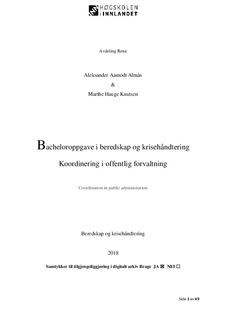| dc.contributor.author | Aamodt Almås, Aleksander | |
| dc.contributor.author | Hauge Knutsen, Marthe | |
| dc.date.accessioned | 2019-01-15T12:18:41Z | |
| dc.date.available | 2019-01-15T12:18:41Z | |
| dc.date.issued | 2018 | |
| dc.identifier.uri | http://hdl.handle.net/11250/2580692 | |
| dc.description | Bacheloroppgave i beredskap og krisehåndtering | nb_NO |
| dc.description.abstract | Temaet for denne bacheloroppgaven er smittebåren trussel. Vi har valgt dette temaet for å belyse samfunnsvitenskapelige moment ved en tematikk og problemstilling vi ikke har mye sammenligningsgrunnlag med, og derfor ønsker å aktualisere. Vi har fokusert på koordinering, kommunikasjon, samordning og usikkerhet i smittevernsarbeidet som kommunalhelsetjenesten skal utføre ved eksempelvis en pandemi. I arbeidet med denne oppgaven har vi benyttet oss av et kvalitativt forskningsdesign og grounded theory for å undersøke temaets kjerne. Empirien vi bygger vår analyse på har vi hentet fra forskjellige kommuner i Norge og Helsedirektoratet. Med bakgrunn i dette formet vi problemstillingen: - Hvordan fungerer Helsedirektoratets rolle som koordinator for kommunehelsetjenestene ved smittebåren trussel eksemplifisert ved pandemisk utbrudd? Vi har brukt teori som grunnlag for å se på hvordan Helsedirektoratetsrolle som koordinator for kommunehelsetjenesten ivaretas. Denne teorien er hentet fra stoff fra pensumlister, litteratursøk og veileders anbefalinger. Vi har sett, både gjennom teori og analyse at koordinatorrollen tolkes forskjellig etter hvor i forvaltningshierarkiet vi befinner oss. Dette har ført oss inn på sporet om uklare linjer i rollefordelingen ved større hendelser som pandemiske utbrudd. Metodisk har vi valgt et kvalitativt design med dybdeintervjuer av nøkkelpersoner vi mener har god kunnskap om fagområdet. Samtidig har vi benyttet oss av flere fremgangsmåter for å få informasjon om konteksten, via en mindre litteraturstudie og frisøk inn i tematikken pandemi. I vår datainnsamling og analyse har vi funn som indikerer at det finnes uklare linjer mellom hvem som har ansvar for hva og hvem som praktisk løser oppgavene. Dette har vi sett som gjennomgående hos alle våre informanter. Dette forekommer også i teorien vi har lest. Ved hjelp av organisasjonsteori har vi sett på hvordan koordinering og avhengigheter gjenspeiler seg i organisasjonene vi har hatt kontakt med. Vi har også sett på forskjellige aspekter ved kommunikasjon mellom kommunehelsetjenestene, både i daglig virke og under en krisesituasjon. Fellesnevneren for våre funn er at rollene mellom Folkehelseinstituttet og Helsedirektoratet er uklare. | nb_NO |
| dc.description.abstract | Engelsk sammendrag (Abstract)
The topic of the bachelor assignment is contagious threats. We have chosen this theme to learn about social sciences on a topic and issue we do not have much comparative basis with and want to actualize. We have focused on coordination, communication and uncertainty in the infection protection work which the municipal health service is to carry out in case of a pandemic event. When working with this assignment we chose to use a qualitative research design called grounded theory to look at the core of our subject. The empiricism we built our analysis from we got from municipalities in Norway and the Norwegian Directorate of Health. From this we got our main issue: - How does the Directorate of Health function as a coordinator for municipal health services when an event involving contagious threats occur exemplified by a pandemic outbreak? Based on theory we got from literature we laid the foundation from which we looked at how the role of the Directorate of Health as a coordinator is being maintained. This led us to the trail of unclear lines within the role distribution of events such as a pandemic outbreak. We chose a qualitative design with in-depth interviews of key people that we believed to have great information because of their familiarity in the area. We also used several other methods for obtaining information on our theme through a minor literature study and research into the thematic of a pandemic event. Our data collection and analysis showed us that there are unclear lines between who owns what responsibility and who actually solves the task within that area of responsibility. This has been a common aspect with all our informants. We have also seen this through several theoretical aspects. Through organizational theory about how coordination and dependencies are reflected in the organizations that we looked at. We also looked at different aspects within communication between the municipal health services, both on a daily and in case of an emergent situation. The common denominator for our findings is that roles within Folkehelseinstituttet and Helsedirektoratet were unclear. | nb_NO |
| dc.language.iso | nob | nb_NO |
| dc.subject | koordinering | nb_NO |
| dc.subject | kommunikasjon | nb_NO |
| dc.subject | kvalitativ metode | nb_NO |
| dc.subject | Grounded Theory | nb_NO |
| dc.subject | Coordination | nb_NO |
| dc.subject | Public Administration | nb_NO |
| dc.subject | offentlig sektor | nb_NO |
| dc.title | Koordinering i offentlig forvaltning | nb_NO |
| dc.title.alternative | Coordination in public administration | nb_NO |
| dc.type | Bachelor thesis | nb_NO |
| dc.subject.nsi | VDP::Samfunnsvitenskap: 200::Statsvitenskap og organisasjonsteori: 240 | nb_NO |
| dc.source.pagenumber | 49 | nb_NO |
